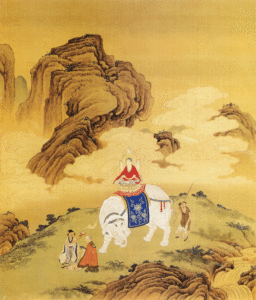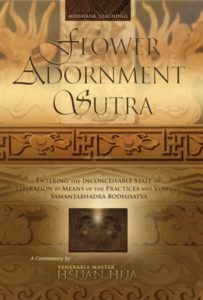吉維辰 整理/翻譯
Compiled and Translated by Ji Weichen VBS 620


Members of the Buddhist Text Translation Society kept working diligently on multi-language translation and publishing of Buddhist scriptures even during the pandemic. Among the English translations, the new English translation of the Flower Adornment (Avatamsaka) Sutra—Chapter 40 (New Edition), the Chapter of “Entering the Inconceivable State of Liberation by Means of the Practices and Vows of Samantabhadra Bodhisattva”, with Commentary by Venerable Master Hua, founder of Dharma Realm Buddhist Association, was published, in addition to publishing the new English translation of Lotus Sutra with Venerable Master Hua’s commentary and the new English translation of Vamalakirti Sutra.
法界佛教總會佛經翻譯委員會於疫情期間,仍孜孜矻矻將佛經翻譯為多種語文。在英譯方面,出版了全新英譯《妙法蓮華經》及法界佛教總會創辦人上宣下化老和尚的淺釋;新版英文《維摩詰經》;也推出新版英譯〈入不思議解脫境界普賢行願品〉,並附宣公上人的淺釋。
The Chapter of “Entering the Inconceivable State of Liberation by Means of the Practices and Vows of Samantabhadra Bodhisattva” is the very last chapter of the Flower Adornment (Avatamsaka) Sutra and is considered one of the most important sacred texts in Mahayana Buddhism because it describes the ten great practices and vows that all Bodhisattvas without exception cultivate in order to become Buddhas. The Venerable Master Hua said, “These king of vows of Samantabhadra Bodhisattva were not just prepared for Samantabhadra Bodhisattva, but they are methods that are taught for all of us living beings. This is because it is to be feared that we living beings might not understand how to cultivate. Samantabhadra Bodhisattva brings forth the heart of compassion and introduces us to these ten kings of vows for the express purpose of teaching us how to cultivate, that is to tell us to rely on these vows in our practice.”
〈普賢行願品〉是《大方廣佛華嚴經》的最後一品,也是大乘佛法中最重要的經文之一。因為〈普賢行願品〉描述了所有菩薩,無一例外,為了成佛所必須修行的十大行願。宣公上人説:「普賢菩薩這個願王,不單是給普賢菩薩預備的,而是給眾生預備的。就是怕眾生不明白如何修行,所以普賢菩薩才發大慈悲心,發明十大願王,叫你去依照他這種大願去修行。」
Venerable Master Hua lectured on this chapter during the 1969 summer cultivation and study session held at the Buddhist Lecture Hall in San Francisco. The lecture series ran for six weeks, from June 16 to July 25, with a two-hour lecture delivered every day, six days a week. The Venerable Master’s lectures, delivered in Chinese, are set forth in English translation in this volume. The translation team of this book, which includes a couple of native Chinese speakers, listened to all of the original lectures in Chinese and then did a thorough review and modification of the English translation of the text and commentary. Members of the translation team included Bhikshus Heng Shun and Jin Yan, Dr. Wang Qingnan, and Dr. Gary Linebarger (the former Dharma Master Heng Tso).
1969年在舊金山佛教講堂舉行的暑期講修班裏,宣公上人自6月16日至7月25日,每週六天,每天講解〈普賢行願品〉兩小時。上人當年以中文講解的內容,如今重新英譯,完整呈現於此書中。新版英譯〈入不思議解脫境界普賢行願品〉的翻譯團隊,有中文母語人士的參與,覆聽上人當年講法錄音,完整對照英譯經文與淺釋,並據以修正英譯。成員包括比丘恒順法師、比丘近巖法師、王青楠博士、藍果佑博士(蓋瑞•藍伯喬,前恒佐法師)等人。
Foreword of this book states that the Venerable Tripitaka Master Hua began lecturing the Flower Adornment Sutra by explaining, in a series of three hundred and seventy-five lectures, Tang Dynasty National Master Qingliang’s Preface and Prologue to the sutra which laid out the foundation for his disciples to listen to the Flower Adornment Sutra. The Venerable Master Hua’s explanation of the sutra text itself, began on November 12, 1972, and was completed on September 9, 1979. In all, the Venerable Master delivered nearly three thousand lectures, spanning almost nine years, on this “king of kings of Buddhist sutras.”
本書前言中指出,三藏法師宣公上人自1971年6月13日起,開講清涼國師的《華嚴經疏序》和《華嚴經疏玄談》,總共講了375回,為弟子們稍後聽講《大方廣佛華嚴經》打下基礎。1972年11月12日起,正式講解「經王之王」《華嚴經》,直到1979年9月9日圓滿,講席將近3000回,連同疏序和玄談,前後歷時近九年。
The chapter begins with the following words by Samantabhadra Bodhisattva:
“Good men! If all of the Buddhas of the ten directions continuously spoke of the merit and virtue of the Tathagata (Buddha) for kalpas (eons) as numerous as the smallest atomic particles in ineffably ineffable numbers of Buddha kshetra-lands, they would not be able to finish. If one aspires to perfect the gateway to the Tathagata’s merit and virtue, one must cultivate ten kinds of great practices and vows.
What are the ten? The first is to worship all Buddhas. The second is to praise the Tathagatas. The third is to extensively cultivate making offerings. The fourth is to repent of karmic obstacles and reform. The fifth is to follow and rejoice in merit and virtue. The sixth is to request the turning of the wheel of Dharma. The seventh is to beseech the Buddhas to remain in the world. The eighth is to always follow and learn from the Buddhas. The ninth is to constantly conform with living beings. The tenth is to transfer all merit and virtue.”
〈普賢行願品〉經文一開始就有普賢菩薩所説:
「善男子,如來功德,假使十方一切諸佛,經不可説不可説佛剎極微塵數劫,相續演說,不可窮盡。若欲成就此功德門,應修十種廣大行願。何等為十?一者、禮敬諸佛;二者、稱讚如來;三者、廣修供養;四者、懺悔業障;五者、隨喜功德;六者、請轉法輪;七者、請佛住世;八者、常隨佛學;九者、恆順眾生;十者、普皆迴向。」
Therefore, if any person wishes to truly walk the road to achieve the enlightenment of a Buddha, they must cultivate these ten practices of Samantabhadra Bodhisattva. In the Shurangama Sutra, there is the following sutra text:
因此任何人想要走上成佛之路,就要修行普賢菩薩十大願。在《楞嚴經》中,也有這樣的經文:
Samantabhadra Bodhisattva arose from his seat, bowed at the Buddha’s feet and said to the Buddha:
“I have been a Dharma Prince with as many Tathagatas (Buddhas) as there are grains of sand in the Ganges. The Tathagatas of the ten directions tell their disciples who have the roots of a Bodhisattva to cultivate the practices of Samantabhadra, which are named after me.
World Honored One, I use my mind to listen and distinguish all the knowledge and views of living beings.
In other regions as many realms away as there are grains of sand in the Ganges, if there is a single living being who in his or her heart discovers the practices of Samantabhadra, I immediately mount my six-tusked elephant, creating hundreds of thousands of division-bodies to go to those places. Although their obstacles may be so heavy that they do not see me, I secretly rub their crown, protect and comfort them, and enable them to be successful.
The Buddha has asked us how we broke through to enlightenment. I have described the basis of my practice: my mind listens with the complete understanding that results from free and unattached discernment. That is the best method.”
普賢菩薩即從座起,頂禮佛足,而白佛言:
「我已曾與恒沙如來為法王子。十方如來,教其弟子菩薩根者,修普賢行,從我立名。世尊!我用心聞,分別眾生所有知見。若於他方恒沙界外,有一眾生,心中發明普賢行者,我於爾時乘六牙象,分身百千,皆至其處。縱彼障深,未得見我。我與其人暗中摩頂,擁護安慰,令其成就。佛問圓通,我說本因,心聞發明,分別自在,斯為第一。」
These passages of sutra text clearly show how fortunate we are to be able to read, study, and practice these incredible vows taught by Samantabhadra Bodhisattva. Dharma Master Heng Shun, the main translator for the new English translation of the “Practices and Vows of Samantabhadra Bodhisattva”, has rare and supreme causes and conditions with this volume. He memorized the entire sutra text of this volume in the late 70’s. Being a westerner, born and grew up in the United States, he could memorize the Chinese version of the “Practices and Vows of Samantabhadra Bodhisattva” and recite it in Chinese for forty minutes each time. One of his vows is to do a certain number of Chinese recitations of this Chapter on the “Practices and Vows of Samantabhadra Bodhisattva” every day in order to transfer merit on behalf of his late mother. This has been his daily practice for years. In the early 90’s, the Venerable Master also told him to recite Samantabhadra Bodhisattva’s repentance verse everyday. Dharma Master Heng Shun feels that the Chapter on the Practices and Vows of Samantabhadra Bodhisattva, repentance and making vows are expounded brilliantly and extensively.
這段《楞嚴經》經文顯示,我們何其幸運,能研讀受持普賢菩薩不可思議的願力。負責新版主譯的恒順法師和〈普賢行願品〉有殊勝的因緣,他在1970年代末期已將〈普賢行願品〉背熟。身為西方人,又在美國土生土長,而他卻能以中文背誦〈普賢行願品〉,一遍大約40分鐘。恒順法師的願力之一就是:每天以中文誦持一定次數的〈普賢行願品〉,為亡母迴向,也成為他的每日定課。1990年代初,宣公上人曾教導恒順法師要每天讀誦〈普賢菩薩懺悔偈〉。恒順法師認為,〈普賢行願品〉對於懺悔和發願有非常精闢的闡述。
The first BTTS edition of “Entering the Inconceivable State of Liberation by Means of the Practices and Vows of Samantabhadra Bodhisattva” was published in 1982. The main translator back then was Dr. Gary Linebarger (formerly known as Heng Tso). He helped with the final editing of this new translation as well. The final step of the translation process before being prepared for publishing was the certification by Bhikshuni Heng Hsien. Bhikshuni Heng Hsien who earned a PhD in Sanskrit and is also fluent in English, Chinese, and French. Dharma Master Heng Hsien joined Dharma Realm Buddhist Association (then Sino-American Buddhist Association) in 1970. Even though she missed the opportunity of listening to Venerable Hua’s lectures on the “Practices and Vows of Samantabhadra Bodhisattva” in 1969, she was able to listen to Venerable Hua’s lectures on the Avatamsaka Sutra starting 1971.
佛經翻譯委員會第一版英譯〈普賢行願品〉於1982年出版,當時負責主譯的是藍果佑博士(前恒佐法師),他也協助新版英譯最後階段的編輯作業。本書英譯完稿並編輯後,還經過慎重的證明程序才付梓,由比丘尼恒賢負責證明工作。恒賢法師不僅中、英、法語流暢,並擁有梵文博士學位。她於1970年加入法界佛教總會(當時稱為中美佛教會),雖未趕上1969年宣公上人講解〈普賢行願品〉的時機,但1971年起,上人從頭講解《大方廣佛華嚴經》,恒賢法師可就沒錯過。
It is a coincidence that Dharma Master Heng Shun’s Chinese monastic name is the same as the first two Chinese characters of the Samantabhadra Bodhisattva’s ninth vow. The Chapter of “Entering the Inconceivable State of Liberation by Means of the Practices and Vows of Samantabhadra Bodhisattva” has been printed and circulated (www.buddhisttexts.org) because all of the causes and conditions have ripened.
巧合的是,恒順法師的中文法號,恰為普賢菩薩第九大願的頭二字。種種因緣成熟促使〈入不思議解脫境界普賢行願品〉的新版英譯,在大眾翹盼中推出問世(www.buddhisttexts.org)。
English readers now have the opportunity to create a deeper karmic affinity with and understanding of the ten king of vows of Samantabhadra Bodhisattva. If they reolve to actually cultivate the ten practices and vows of Samantabhadra Bodhisattva, he will certainly secretly rub their crown, protect and comfort them, and enable them to be successful (in cultivation)as this great Bodhisattva vowed in front of the Buddha.
讓英語讀者有更好的機緣,深入普賢十大願王,若能因此機緣發心修行普賢十大行願,必得普賢菩薩「暗中摩頂,擁護安慰,令其成就」,正如這位大菩薩在佛陀面前所發的誓願。♣
